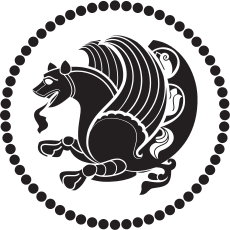Seven Great Houses of Iran
The Seven Great Houses of Iran,[1] also known as the seven Parthian clans, were seven feudal aristocracies of Parthian origin, who were allied with the Sasanian court.
The seven great houses of Iran had played an active role in Iranian politics since the Arsacid Empire, which they continued to do under their successors, the Sasanians.[2] Only two of the seven – the House of Suren and the House of Karen – however, are actually attested in sources date-able to the Parthian period. The seven houses claimed to have been confirmed as lords in Iran by the legendary Kayanian king Vishtaspa.[2] "It may be that [...] members of them made up their own genealogies in order to emphasize the antiquity of their families."[3] During Sasanian times, the seven feudal houses played a significant role at the Sasanian court. Bahram Chobin, a famed military commander of Hormizd IV (r. 579–590), was from the House of Mihran.
The seven houses with their respective main fiefs and ruling-family seats were:
- the House of Ispahbudhan, of Gurgan[4]
- the House of Varaz, of Eastern Khorasan
- the House of Karen, of Nahavand[4]
- the House of Mihran, of Ray
- the House of Spandiyadh, of Ray
- the House of Zik, of Adurbadagan
- the House of Suren, of Sakastan[4]
References
- Pourshariati 2008, p. 44.
- Shahbazi 2002, pp. 511-515.
- Lukonin 1983, p. 704.
- Pourshariati 2008, p. 49.
Sources
- Lukonin, V. G. (1983), "Political, Social and Administrative Institutions", in Yarshater, Ehsan (ed.), Cambridge History of Iran, 3.2, London: Cambridge UP, pp. 681–747
- Yarshater, Ehsan (1997), "Esfandīār (2)", Encyclopedia Iranica, vol. 8, Costa Mesa: Mazda, pp. 592–593.
- Pourshariati, Parvaneh (2008), Decline and Fall of the Sasanian Empire: The Sasanian-Parthian Confederacy and the Arab Conquest of Iran, London: I.B. Tauris.
- Shahbazi, A. Shapur (2002). "Haft". Encyclopaedia Iranica, Vol. XI, Fasc. 5. pp. 511–515.CS1 maint: ref=harv (link)
